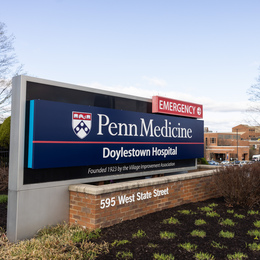
Changing for the Better
The area’s top health systems transform how and where area residents receive care.
Recent headlines regarding the state of health care in the Philadelphia area have been dominated by the closure of Crozer Health, the largest health system in Delaware County. Even so, residents of Philadelphia and surrounding communities enjoy tremendous access to some of the nation’s best health care, largely due to the efforts of some extraordinarily talented clinicians and researchers. Other recent developments close to home show how local health systems are reshaping how and where area residents tend to their health and well-being.
* Children’s Hospital of Philadelphia has a long history of conducting groundbreaking research to address threats to pediatric health. The details of one of those historic breakthroughs was recently published in The New England Journal of Medicine. An infant, known as KJ, was diagnosed with a rare metabolic disease known as severe carbamoyl phosphate synthetase 1 (CPS1) deficiency, which, according to the National Organization for Rare Disorders, can cause vomiting, refusal to eat, progressive lethargy, and coma. Typically, patients with CPS1 deficiency are treated with a liver transplant, though they need to be medically stable and old enough to tolerate such a significant procedure. In KJ’s case, a team at CHOP and Penn Medicine sought to address the genetic disorder with a customized CRISPR gene-editing therapy. In February 2025, after spending the first several months of his life in the hospital, KJ received the first dose of his customized therapy. KJ began to thrive thereafter, an example of the personalized nature of medicine’s future.
* When Doylestown Health completed its integration with Penn Medicine in April, Doylestown Health CEO Jim Brexler said the Bucks County institution was “writing the next chapter in our storied history that began more than 100 years ago.” Doylestown Health’s modest roots date back to 1895, when 14 women set out to address persistent respiratory illness throughout the community brought about by the area’s dusty, unpaved streets. It ultimately grew into a sprawling health system with a 245-bed teaching hospital, an urgent care center, a homecare service, multiple outpatient offices, and a medical staff of 600 providers in more than 50 specialties. Penn Medicine believed Doylestown Health was a good fit due to the organizations’ shared values—a commitment to providing high-quality care, excellence and continuous improvement among care providers and staff, and an appetite for collaboration.
It’s been a rather busy spring for Penn Medicine, which recently broke ground on a four-story, 162,000-square-foot multispecialty outpatient facility that will expand options for patients to receive advanced care in Montgomery and Bucks counties. Set to open in late 2027, Penn Medicine Montgomeryville will provide comprehensive cancer care, including radiation oncology services and chemotherapy provided by the Abramson Cancer Center. Additional services will include primary care, heart and vascular, orthopedic and neuroscience care, and specialized services in women’s health and surgical consultations.
* Main Line Health and its hospitals and physicians continually earn awards, certifications, and other accolades, ranging from “Great Place to Work” and “Pathway to Excellence” designations, to citations for exemplary safety, to Philadelphia magazine’s Top Doctors honors. The health system is also a pioneer in terms potentially life-saving research. For example, Main Line Health’s Lankenau Institute for Medical Research recently became the first clinical trial site in the United States to offer a novel investigational therapy aimed at treating advanced and metastatic prostate cancer; this type of late-stage cancer has limited treatment options and often has a high mortality rate. The phase 2a LEGION-100 trial seeks to evaluate the safety and effectiveness of the SYNC-T/SV-102 combination therapy for treating metastatic castration-resistant prostate cancer and to identify the maximum tolerated dose. In a phase 1 trial of the combination therapy, 11 of 13 patients responded to treatment. Five patients had a complete response, meaning every tumor visible through imaging was eradicated, while the other six patients had a partial response.
* Change is afoot at two hospitals under the Prime Healthcare umbrella: Suburban Community Hospital in East Norriton and Roxborough Memorial Hospital in the city’s Roxborough neighborhood. Suburban Community Hospital has transformed into the Suburban Behavioral Health Campus of Roxborough Memorial Hospital. The initiative reflects the two hospitals’ shared commitment to addressing the increasing behavioral health needs within their communities and reinforces their mission of providing compassionate, high-quality care to all individuals. The newly established Suburban Behavioral Health Campus will reactivate 15 geropsychiatry beds to ensure that seniors receive the specialized care they require. Roxborough Memorial Hospital, for its part, has a 24-bed inpatient care Senior Behavioral Health Unit designed to meet the behavioral health needs of adults aged 65 and older. The unit program offers comprehensive treatment for conditions such as depression, psychosis, bipolar disorder, and anxiety.
In addition to behavioral health initiatives, Roxborough Memorial Hospital has launched a Bariatric Surgery and Wellness Program for individuals struggling with obesity, to include surgical options such as gastric bypass and sleeve gastrectomy, as well as promoting weight loss and enhancing overall health by regulating metabolism and addressing related health issues. The hospital also recently established an Inpatient Rehabilitation Unit to ensures the best possible outcomes for those in recovery, allowing them to regain their independence and resume their daily activities.
* Trinity Health Mid-Atlantic Medical Group Cardiology was formed through the coming together of existing cardiology practices at St. Mary Medical Center and Nazareth Hospital. The new group’s two office locations are located within the office buildings of St. Mary Medical Center in Langhorne and Nazareth Hospital in Philadelphia. Langhorne’s staff will include seven existing physicians, two new physicians, eight advanced practice providers, and 30 support staff, while Philadelphia’s staff will include five existing physicians, one new physician, three advanced practice providers, and 15 support staff.
Invested in the Health of Communities
Less than a year has passed since Jefferson Health and Lehigh Valley Health Network (LVHN) closed on the transaction that made them into one combined health system. We spoke with Baligh R. Yehia, M.D., FACP, president of Jefferson Health and executive vice president of Jefferson, to find out how bringing LVHN into the Jefferson fold could improve quality of life for residents in the Lehigh Valley in the years to come.
Q&A
Why was LVHN considered a vital addition to Jefferson Health?
The Lehigh Valley Health Network has a more than 100-year legacy of providing world-class, leading-edge care and making investments in the communities it serves. Combined with Jefferson’s 200-year legacy, serving the greater Philadelphia area, we can provide patients with enhanced access and an even more robust care team. Our continued integration now includes LVHN staff members serving in leadership roles with Jefferson, including in cancer, orthopedic, and neurosciences.
What positive changes will Jefferson bring to area residents who have relied on LVHN for their health care needs?
First and foremost, the combination of Jefferson Health and LVHN will provide patients with unmatched access to care throughout the region. We now have more than 700 locations and 32 hospitals across Pennsylvania and New Jersey where people can receive nationally ranked, award-winning care. Our combination also offers a more expansive and affordable health care plan through Jefferson Health Plans, a not-for-profit health plan that helps vulnerable, at-risk individuals, including those on Medicare and Medicaid, access the care they deserve. Additionally, staff members will benefit from the new education and professional development opportunities through Thomas Jefferson University. The university helps us create a pipeline of clinical talent in the LVHN region, which is especially valuable right now as many institutions are challenged by a national workforce shortage.
Less than a year has passed since Jefferson Health and Lehigh Valley Health Network (LVHN) closed on the transaction that made them into one combined health system. We spoke with Baligh R. Yehia, M.D., FACP, president of Jefferson Health and executive vice president of Jefferson, to find out how bringing LVHN into the Jefferson fold could improve quality of life for residents in the Lehigh Valley in the years to come.
Q&A
Why was LVHN considered a vital addition to Jefferson Health?
The Lehigh Valley Health Network has a more than 100-year legacy of providing world-class, leading-edge care and making investments in the communities it serves. Combined with Jefferson’s 200-year legacy, serving the greater Philadelphia area, we can provide patients with enhanced access and an even more robust care team. Our continued integration now includes LVHN staff members serving in leadership roles with Jefferson, including in cancer, orthopedic, and neurosciences.
What positive changes will Jefferson bring to area residents who have relied on LVHN for their health care needs?
First and foremost, the combination of Jefferson Health and LVHN will provide patients with unmatched access to care throughout the region. We now have more than 700 locations and 32 hospitals across Pennsylvania and New Jersey where people can receive nationally ranked, award-winning care. Our combination also offers a more expansive and affordable health care plan through Jefferson Health Plans, a not-for-profit health plan that helps vulnerable, at-risk individuals, including those on Medicare and Medicaid, access the care they deserve. Additionally, staff members will benefit from the new education and professional development opportunities through Thomas Jefferson University. The university helps us create a pipeline of clinical talent in the LVHN region, which is especially valuable right now as many institutions are challenged by a national workforce shortage.
The care teams that patients trust and rely on will continue to provide care in their communities. We are deeply invested in the communities that LVHN serves and will continue to invest in care, services and programs to help patients and staff thrive. This includes additional neighborhood hospitals, a new behavioral health hospital, and a women’s health center.
Will there be new services available to LVHN patients as a result, either now or in the near future?
Jefferson and LVHN patients can expect to continue receiving the high-quality care that they have come to trust for many years and we will continue to expand all specialties across the different locations. Both health systems have been at the forefront of bringing the best and latest treatments to their communities, and we expect that to continue at an even faster rate together.
Will there be new services available to LVHN patients as a result, either now or in the near future?
Jefferson and LVHN patients can expect to continue receiving the high-quality care that they have come to trust for many years and we will continue to expand all specialties across the different locations. Both health systems have been at the forefront of bringing the best and latest treatments to their communities, and we expect that to continue at an even faster rate together.
Jefferson and LVHN are integrating all clinical services, so patients will have access to services throughout both health systems. Since coming together, LVHN now offers stem and cellular therapies, including the cutting-edge car-T therapy, and is the first in the region to offer liver transplants. LVHN has also expanded its tremor treatment that utilizes sound waves guided by MRI to Jefferson’s other locations.
Photo courtesy of Penn Medicine
Published (and copyrighted) in Suburban Life magazine, May 2025.


